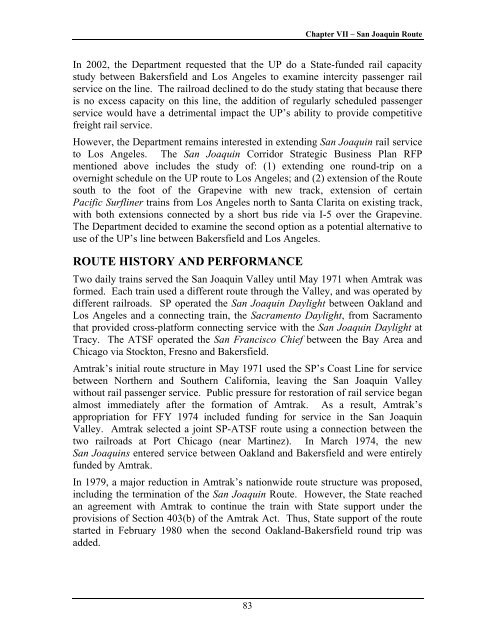California State Rail Plan 2005-06 to 2015-16
California State Rail Plan 2005-06 to 2015-16
California State Rail Plan 2005-06 to 2015-16
You also want an ePaper? Increase the reach of your titles
YUMPU automatically turns print PDFs into web optimized ePapers that Google loves.
Chapter VII – San Joaquin Route<br />
In 2002, the Department requested that the UP do a <strong>State</strong>-funded rail capacity<br />
study between Bakersfield and Los Angeles <strong>to</strong> examine intercity passenger rail<br />
service on the line. The railroad declined <strong>to</strong> do the study stating that because there<br />
is no excess capacity on this line, the addition of regularly scheduled passenger<br />
service would have a detrimental impact the UP’s ability <strong>to</strong> provide competitive<br />
freight rail service.<br />
However, the Department remains interested in extending San Joaquin rail service<br />
<strong>to</strong> Los Angeles. The San Joaquin Corridor Strategic Business <strong>Plan</strong> RFP<br />
mentioned above includes the study of: (1) extending one round-trip on a<br />
overnight schedule on the UP route <strong>to</strong> Los Angeles; and (2) extension of the Route<br />
south <strong>to</strong> the foot of the Grapevine with new track, extension of certain<br />
Pacific Surfliner trains from Los Angeles north <strong>to</strong> Santa Clarita on existing track,<br />
with both extensions connected by a short bus ride via I-5 over the Grapevine.<br />
The Department decided <strong>to</strong> examine the second option as a potential alternative <strong>to</strong><br />
use of the UP’s line between Bakersfield and Los Angeles.<br />
ROUTE HISTORY AND PERFORMANCE<br />
Two daily trains served the San Joaquin Valley until May 1971 when Amtrak was<br />
formed. Each train used a different route through the Valley, and was operated by<br />
different railroads. SP operated the San Joaquin Daylight between Oakland and<br />
Los Angeles and a connecting train, the Sacramen<strong>to</strong> Daylight, from Sacramen<strong>to</strong><br />
that provided cross-platform connecting service with the San Joaquin Daylight at<br />
Tracy. The ATSF operated the San Francisco Chief between the Bay Area and<br />
Chicago via S<strong>to</strong>ck<strong>to</strong>n, Fresno and Bakersfield.<br />
Amtrak’s initial route structure in May 1971 used the SP’s Coast Line for service<br />
between Northern and Southern <strong>California</strong>, leaving the San Joaquin Valley<br />
without rail passenger service. Public pressure for res<strong>to</strong>ration of rail service began<br />
almost immediately after the formation of Amtrak. As a result, Amtrak’s<br />
appropriation for FFY 1974 included funding for service in the San Joaquin<br />
Valley. Amtrak selected a joint SP-ATSF route using a connection between the<br />
two railroads at Port Chicago (near Martinez). In March 1974, the new<br />
San Joaquins entered service between Oakland and Bakersfield and were entirely<br />
funded by Amtrak.<br />
In 1979, a major reduction in Amtrak’s nationwide route structure was proposed,<br />
including the termination of the San Joaquin Route. However, the <strong>State</strong> reached<br />
an agreement with Amtrak <strong>to</strong> continue the train with <strong>State</strong> support under the<br />
provisions of Section 403(b) of the Amtrak Act. Thus, <strong>State</strong> support of the route<br />
started in February 1980 when the second Oakland-Bakersfield round trip was<br />
added.<br />
83













